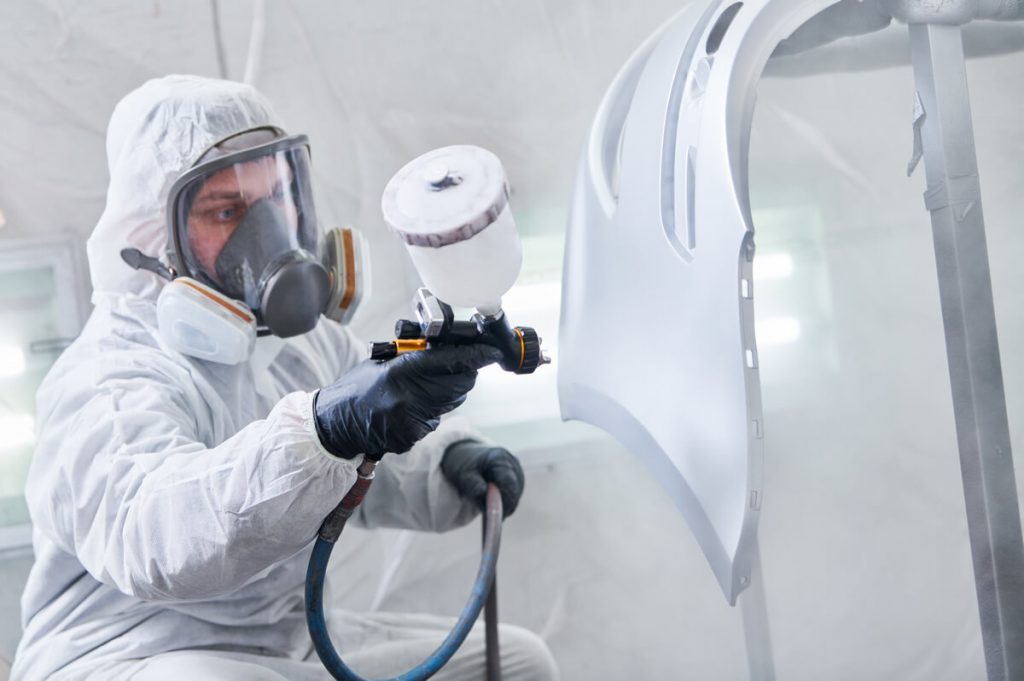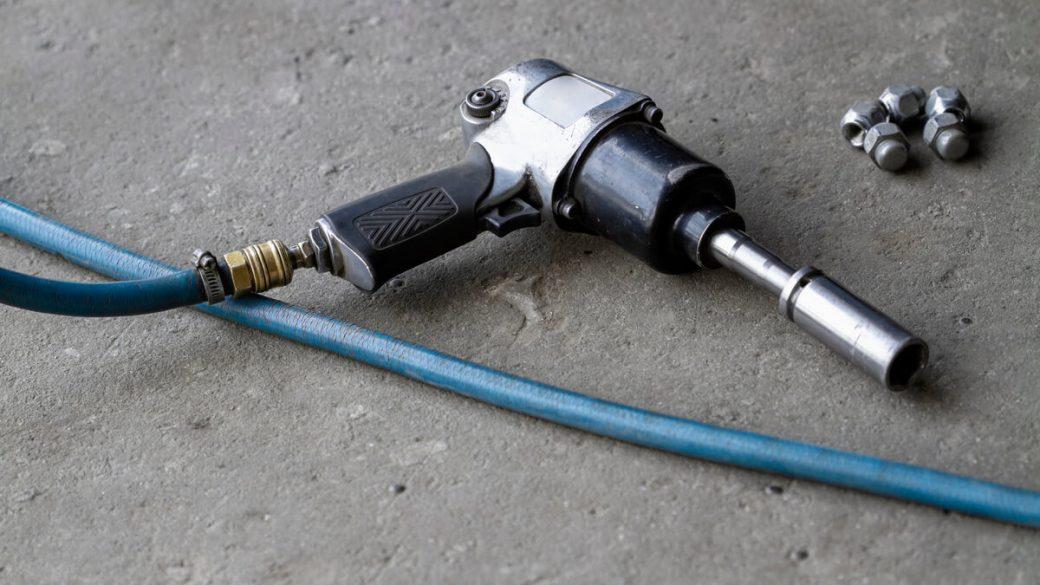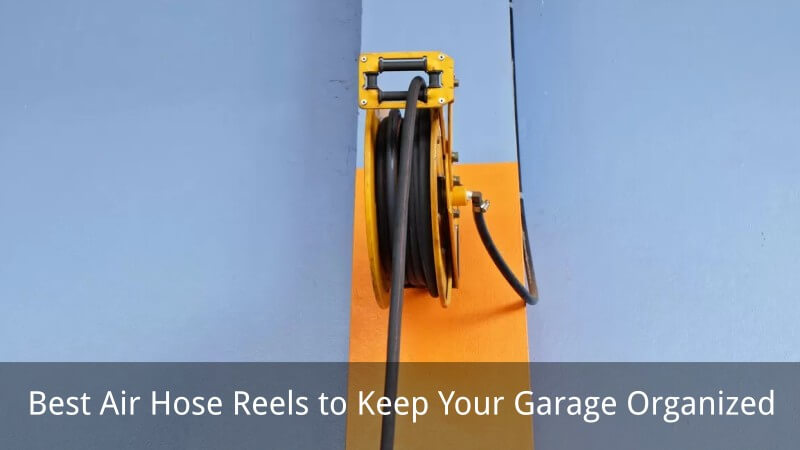
- Length: 50 ft.
- Material: Rubber
- Pressure rating: 300 PSI
- Working temperature: -30º to 200º F
- Threads: 3/8-inch
- Fittings: 1/4-inch NPT
- Protection against: abrasion, oil, kinking
- Color: black
- 3-year warranty

- Length: 50 ft.
- Material: Rubber
- Pressure rating: 300 PSI
- Working temperature: -40º to 226º F
- Threads: 3/8-inch
- Fittings: 1/4-inch NPT
- Protection against: abrasion, oil, puncture, corrosion (for the reel)
- Color: Yellow
- Heavy-duty powder-coated steel reel
- 1-year warranty
An air compressor without a hose is essentially like a car without wheels; it’s virtually useless. Indeed, air hoses channel the compressed air, allowing the compressor to accomplish what it’s designed for—powering pneumatic tools, such as air-powered impact wrenches, ratchets, and grinders. Of course, that’s not even covering the endless list of use cases outside the garage, like flashing out clogged pipes, pressure washing, and many more.
If you just got yourself a brand-new compressor, you might realize quite quickly that air hoses don’t last forever—not to mention that some air compressors don’t even come with one while others are initially equipped with rather cheap ones from the factory. At some point, you’ll need to buy a new hose and you’ll see that there’s a sea of options out there. To help you find the best one depending on your specific needs and budget, we have reviewed the top five air compressor hoses we could find out there, covering the main pros and cons of each, and provided a complete buying guide with a couple of things to consider when buying one.
Hope it helps!
Table of Contents
Air Compressor Hose Reviews
Listed below are five of the best air hoses you can find in the market today. These hoses are made by some of the most credible aftermarket manufacturers, and all of them are durable enough to face any heavy-duty type of work in the garage.
For comparison purposes, the air hoses we have selected are all 3/8-inch in diameter with 1/4-inch NPT fittings, which is basically the industry standard. Of course, most hose manufacturers also make the same models in larger diameters but unless you work on semi-trucks and use 1/2″-drive tools and bigger, 3/8″ hoses should be more than enough.
So without further ado, let’s dive in!
1. Campbell Hausfeld PA117701AV Air Hose — Budget Pick
[amazon fields=”B000BOAB9K” value=”thumb” image_size=”large” image_alt=”Campbell Hausfeld PA117701AV Air Hose”]
Of course, the Campbell Hausfeld PA117701AV isn’t the best air hose out there—not even close. Still, it’s pretty good at what it does and will still do the job just fine. The main point here is that it’s super cheap, making it perfect for light-duty work. After all, if you only use it to inflate and change tires every 6 months, there’s no reason to spend big bucks on a premium model for nothing.
CH’s entry-level model is made out of polyvinyl chloride (PVC) and is available in either 25 or 50 ft. And interestingly, despite being our budget pick, it can handle a maximum pressure of 300 PSI, just like the more high-end models. In fact, 300 PSI is the industry standard and is more than enough to power even the more air-hungry tools. Moreover, there’s a soft inner lining that lowers the friction when air passes through the hose, increasing the efficiency of your air compressor.
However, it’s important to mention that it’s made of a stiff PVC material, which might be a problem in extreme weather. In winter, the hose will tend to get even stiffer and kink easily—not an ideal condition when trying to fit into tight spots. In summer, PVC tends to dry out and crack—not ideal either.
So why did we include it in the list then? Because, as said before, despite not being the absolute best, it’s still one of the best budget-friendly models out there. Yes, the cheaper PVC won’t last as long as rubber or hybrid materials but will still do the job just fine. Let’s not forget that not everyone needs heavy-duty stuff all the time.
Put simply, if you need a hose to use a couple of times a week or month, get this one. But if you are a serious weekend DIYers or even a professional mechanic, we have much better options below.
Key Features
- Length: 25 ft.
- Material: PVC
- Pressure rating: 300 PSI
- Working temperature: 0º to 130º F
- Threads: 3/8-inch
- Fittings: 1/4-inch NPT
- Protection against: abrasion, corrosion, oil
- Color: Blue
- 1-year warranty
Pros
- Highly affordable
- Soft inner lining for better efficiency
- Lightweight
Cons
- Kinks easily
- PVC material isn’t ideal for extreme climate
2. Flexzilla HFZ3825YW2 Air Hose — Best Hybrid Model
[amazon fields=”B0021WVO8W” value=”thumb” image_size=”large” image_alt=”Flexzilla HFZ3825YW2 Air Hose”]
If you’re looking for the best hybrid air hose, the Flexzilla HFZ3825YW2 is your best bet. Not only is it reasonably priced, but it’s also offered in various lengths (25, 50, and 100 ft.) and has a complete selection of hose threads and fittings sizes available (1/4-, 3/8-, and 1/2-inch) to match various air compressors and air tools.
Hybrid air hoses are very flexible and can withstand extreme temperatures, and Flexilla air hoses deliver those traits flawlessly. Rated at 300 PSI, this hose could handle freezing temperatures as low as -40 degrees Fahrenheit, perfect if you live in an Alaskan-like climate. Furthermore, it’s also protected against abrasion, has a crush-resistant aluminum connector, and comes with a 2-year warranty—what’s more to ask?
However, the tradeoff for its extreme flexibility is that it can get twisted relatively easily, leading it to recoil in an unorganized manner (I would suggest an air hose reel to prevent that). Still, if you can forgive this minor drawback, the Flexilla hybrid hose is an affordable heavy-duty model, perfect for those living in colder regions—and no need to live in Alaska here. If you work below 0°C, this one is a much better, still relatively cheap alternative to Campbell Hausfeld’s model above.
Key Features
- Length: 25 ft.
- Material: Hybrid
- Pressure rating: 300 PSI
- Working temperature: -40º to 140º F
- Threads: 3/8-inch
- Fittings: 1/4-inch NPT
- Protection against abrasion, crushing, and kinking
- Color: ZillaGreen
- 2-year warranty
Pros
- Made in the USA
- Large variety of fitting sizes and couplings
- Extremely durable and has a very low working temperature
- Crush resistant aluminum connector with bend restrictors
- Still relatively affordable despite the noble warranty
Cons
- Can twist fairly easily
3. Craftsman CMXZTSG1082NB Air Hose — Editor’s Pick
[amazon fields=”B08PDTPBYB” value=”thumb” image_size=”large” image_alt=”Craftsman CMXZTSG1082NB Air Hose”]
Holding our Editor’s Pick title, the Craftsman CMXZTSG1082NB makes it hard for us to find a better air hose for the price. And since it’s made of rubber, it stays flexible in winter and won’t dry out in summer—a pretty good deal, if you ask me!
However, it’s important to mention that this rubber air hose is only offered in one spec—50 ft. long, 3/8-inch diameter, and 1/4-inch NPT fittings—pretty much the industry standard for repair shops. Consequently, it’s perfect for any automotive-oriented garage and will be compatible with most air compressors. And to be honest, if 50 ft. is too long for you, cut it in half, crimp a fitting on each end, and voila, you now have an extra hose for basically nothing!
Since it’s mainly intended for professional use, it’s also rated at 300 PSI and has an extreme working temperature range of -30° to 200° F (-35 to 94° C). No matter how unpleasant/harsh your climate is, Craftsman’s hose is still ready to get to work!
Minor downsides are that rubber hoses are dirt magnets and quite heavy, although both are easily forgivable. In a shop, a black hose and a red hose will both be just one color after a while—black. And regarding the weight, we would once again recommend a hose reel here (otherwise, I would suggest going for a shorter and lighter model instead).
Craftsman also redeems itself by equipping this air hose with protections against abrasion and oil and a highly generous 3-year warranty. Besides, rubber doesn’t kink or tangle, even after prolonged use, which is not negligible.
Overall, the Craftsman CMXZTSG1082NB is a long, extremely durable, and affordable air compressor hose with loads of attractive features. If that’s not a complete package, we don’t know what is.
Key Features
- Length: 50 ft.
- Material: Rubber
- Pressure rating: 300 PSI
- Working temperature: -30º to 200º F
- Threads: 3/8-inch
- Fittings: 1/4-inch NPT
- Protection against: abrasion, oil, kinking
- Color: black
- 3-year warranty
Pros
- Perfect for auto mechanics
- Extreme working temperature range
- Kink- and tangle-free
- Affordable for the length
- Dark color for invisible dirt
- Generous warranty
Cons
- Heavy
- Rubber material is easy to get dirty
- Not offered in shorter form
- Only one diameter size available
4. Primefit PUR38050P Recoil Hose — Best Recoil Air Hose
[amazon fields=”B016S0B0GS” value=”thumb” image_size=”large” image_alt=”Primefit PUR38050P Recoil Hose”]
The Primefit PUR38050P is the only polyurethane hose on this list and has plenty of tricks up its sleeve. First off, the pigtail-style self-coiling form makes it super convenient to manage and store. It’s also a neat alternative when working in a smaller garage or if you don’t want to invest in a reel. Thanks to the coil shape, it will automatically retract once you are done using it. However, it can be a bit bulky to always pull the whole thing around.
Moreover, it has the lowest pressure rating on this list at 120 PSI, which can be a drawback if you operate larger, heavy-duty air tools. Still, if you only use auto mechanics tools, it should be more than enough (there are only limited situations where you might need to run a 1/2″-drive impact wrench higher than 120 psi). Moreover, it has a large working temperature range (-30° to 150° F) and is protected against abrasion, oil, cracking, and bending. The hose material is suited for cold climates as its self-coiling body allows it to stay flexible in all conditions.
Another slight problem with recoil hoses is that they are quite prone to tangling, and as they won’t lay flat on the floor, you might trip on them. A neat trick here is to route the hose overhead so it retracts above you when not in use while still staying within reach. It’s really a question of personal preference here. I personally hate recoil hoses but several mechanics only swear by them. If it’s your case, this one is a no-brainer!
Key Features
- Length: 50 ft.
- Material: Polyurethane
- Pressure rating: 120 PSI
- Working temperature: -30º to 150º F
- Fittings: 1/4-inch NPT
- Protection against: abrasion, oil, cracking, bending
- Color: blue
- 1-year warranty
Pros
- Self-coiling for added convenience
- Compact
- Easy to store
Cons
- The self-coiling form could be trippy when unnoticed
- Tangles easily
5. Goodyear L815153G Air Hose Reel — Premium Pick
[amazon fields=”B01GFA35N2″ value=”thumb” image_size=”large” image_alt=”Goodyear L815153G Air Hose Reel”]
The Goodyear L815153G is a proper heavy-duty air hose in a premium package, as is expected from a brand that only delivers high-quality rubber materials. It’s 50 ft. long—more than enough for most home garages—and comes in a sturdy steel reel that can be mounted on the roof/wall.
But the most important feature of this air hose is its durability. Not only is it rated at 300 PSI, but it also has the widest operating temperature range on this list. With a range between -40° and 226° F (-40° to 108° C), you can pretty much throw any climate at it, and it will still work perfectly fine. Not to mention that it’s made from a sturdier synthetic rubber that’s puncture-resistant and meant to last for years.
Unfortunately, it does come at a premium price. And to properly use the reel, you’ll still need a whip hose that needs to be bought separately. Still, if you own a repair shop or do serious repairs in your garage, you can’t go wrong with this one. If money isn’t an issue, the Goodyear L815153G could very well be one of the best investments a mechanic can make.
Key Features
- Length: 50 ft.
- Material: Rubber
- Pressure rating: 300 PSI
- Working temperature: -40º to 226º F
- Threads: 3/8-inch
- Fittings: 1/4-inch NPT
- Protection against: abrasion, oil, puncture, corrosion (for the reel)
- Color: Yellow
- Heavy-duty powder-coated steel reel
- 1-year warranty
Pros
- Comes with a built-in reel
- Extreme working temperature range
- Kink- and tangle-free
Cons
- On the expensive side
- Whip hose sold separately
- Yellow color gets dirty pretty quick
Types of Air Compressor Hoses
Rubber
Rubber is the most popular air hose material and the go-to type when money is not a concern. It’s abrasion-free, extremely durable, and doesn’t kink as easily as PVC. The operating temperature range is also usually wider than with other materials, making it suitable to be used in extreme climates without losing its flexibility.
It’s also important to mention that leaking rubber hoses are also much easier to fix. Since it’s the same material used for tires, any standard flat tire repair kit will do here.
Nonetheless, this material also has its drawbacks. For instance, it is the heaviest material used for air hoses and it does tend to pick up dirt as it is dragged along the floor (rubber creates static electricity). That said, an easy fix is to install a wall- or ceiling-mounted hose reel and prevent it from dragging on the floor all the time.
Polyvinyl Chloride (PVC)
PVC hoses are also abrasion-resistant and highly durable. They’re typically the cheapest but also the stiffest amongst the different materials available.
However, keep in mind that this material works best in hotter temperatures, as cold climates make the already stiff hose even harder to manage. It tends to kink, making it almost impossible to lay flat on the floor and kink points will also tend to leak a lot faster.
Polyurethane
Polyurethane is the lightest air hose material and is frequently used to make recoil air hoses (but not exclusively). The lighter material is perfect for compact and portable hoses and still works quite well in winter.
However, polyurethane is also the costliest material and tends to kink and tangle over time. Not to mention that anything that coils on the floor is a safety hazard.
Hybrid
Hybrid air hoses are made from 2 or more of the previously mentioned materials (rubber, PVC, and polyurethane), hoping to combine the pros while leaving the cons out. They are flexible, can handle extreme temperatures and despite sharing plenty of characteristics with rubber, hybrid hoses are much lighter and less of a dirt magnet. Sadly, they are still a victim of kinking after prolonged use—nothing is perfect, right?
What to Consider When Buying an Air Compressor Hose
Hose Length
Depending on the type of work you do and the configuration of your garage, you might need air hoses of different sizes. Luckily, air hoses come in various lengths, ranging from 6-100 feet. However, in most cases, cases, 25 or 50 ft. should be more than enough. And keep in mind that the longer the hose, the harder your compressor will have to work to keep the pressure where you want it.
If air pressure isn’t a concern and you need better mobility, 50+ ft. hoses will better serve your needs. But once again, unless you frequently need to work 50 to 100 ft. away from your compressor, I would suggest buying 2 X 25 ft. or 2X 50 ft. instead. This way you can even install a splitter on your compressor, connect 2 or more hoses to it, preventing from having to connect and disconnect tools every time you need to change. And when you need to work farther away, you can just combine more than one hose, one after the other, and still have a 100 ft. hose.
Internal Diameter
The hose’s internal diameter decides what type of valve it can fit on and how much airflow it can deliver. Usually, your choice needs to match your air compressor’s CFM requirement (volume of air delivered at PSI level). You can find the required CFM of an air compressor in the owner’s manual or use an online CFM calculator.
Nowadays, the diameter options are down to either 1/4, 3/8, or 1/2-inch. Picking between them depends on the size of your air compressor. A smaller air compressor with less CFM requirement works perfectly with the smaller 1/4 inch models and is enough for inflating tires or powering a blowgun. However, most air compressors used in the automotive industry should be paired with at least 3/8 inch hoses. And if you work on bigger equipment or use power tools with a higher CFM requirement, you should probably go for 1/2-inch air hoses instead.
Fittings and Connector Style
Deciding on the connector and fitting style is possibly the most confusing part of buying an air hose. But we can assure you that as long as you got them matched, you’re good to go.
Air hoses have dozens of different fittings, but three of the most common ones are BSP (British Standard Pipe), PCL (Pneumatic Components Ltd), and NPT (National Pipe Tapering). In the US and Canada, most air compressors and hoses often come preinstalled with NPT style fittings, either 1/4- or 1/2-inch diameter.

With the fittings settled, you’ll then need to attach the coupler/connector to connect the hose ends to the air compressor and the pneumatic tool. Usually, air hoses are supplied with either a quick-release or thread-fixing style connectors. A male quick-release plugs into a female quick-release, while male thread screws into a female thread. Both styles work flawlessly, but keep in mind that a cross-marriage between different styles won’t work. So you need to make sure your air hose comes with a complete set of the correct couplings.
Once again, if you need to connect multiple air hoses, simply buy additional connectors/couplers with matching styles and sizes and you’ll be able to connect as many air hoses as you want.
Pressure Rating (PSI)
The pressure rating of an air hose refers to the maximum amount of air pressure it can handle, measured in pounds per square inch (PSI). For common garage use cases like inflating tires or powering a paint gun, 150 PSI should be more than enough. Still, the higher the PSI rating, the more robust and more durable the hose components. So as a general rule, a hose rated at 300psi will usually be better than one rated at 200psi, even though you only really need 150psi.
Thankfully, most air hoses nowadays are rated at 300 PSI, which is far from weak. Hence, they should be able to handle whatever you can throw at them and for a really long-time (as long as you keep using them within their working temperature).
Temperature Resistance
These days, air hoses have excellent resistance towards extreme temperature, and the high-quality ones can handle the worst climates possible. However, that doesn’t mean you shouldn’t still double-check if the claimed working temperature fits your specific region.
Rubber is by far the best air hose material for handling extremely high and low temperatures. For instance, the Craftsman CMXZTSG1082NB can survive temperatures as low as -30° F and as high as 200° F—that’s more than enough to handle any climate in the US without a doubt.
Kink Resistance
Kinking is something you should avoid. When a hose starts to kink (which is often the case after prolonged use), it creates pinch points, reducing the flow of the pressurized air and diminishing the overall performance. Hence, the best solution is to go with a kink-resistant hose material, which is also rubber. Though, if you decide to go with polyurethane, PVC, or hybrid hoses, you can still prevent them from kinking too soon by using and storing them carefully.
Standard Hose vs. Recoil Hose
When it comes to the shape, there are two different options—standard or recoil hoses. A standard hose has no memory of any bend or coil, allowing it to lie flat on the floor. However, you do need to wrap it in loops manually for easy storage. And while rubber and hybrid hoses are quite flexible, PVC ones can be quite hard to roll due to the stiffness—not to mention that rolling a 50 ft. hose every time kinda sucks.
Recoil hoses, on the other hand, are commonly made of polyurethane and feature shape memory. They’re highly flexible and can be stretched as far as they’ll go, and then recoil back to their original twisted form once you let go of the end. These hoses are usually lightweight and very convenient to store and carry around. However, they also tangle easily and can be safety concerns when not mounted overhead.

Frequently Asked Questions (FAQs)
How do I know if I need a new air compressor hose?
There are a few good reasons why you need to buy a new air hose. Firstly, the purchase of an air compressor device doesn’t always include a built-in air hose. And even if it does, it won’t always match your needs. In that case, you’ll need to buy one that will fit your specific needs and budget separately.
Secondly, air hoses are prone to damage or leak (recognizable by the high-frequency hissing sounds associated with air leaks). And regardless of how often/seldom you use it, your hose will eventually wear/crack/dry out someday and will need to be replaced need to replace it. Luckily, while you might see it as another unnecessary expense, it’s actually a good opportunity to invest in a decent model that will last longer than the previous one and save you some money in the long term.
Can I use an air hose as a water supply?
Yes, you can. Considering you have garden hose fittings, you can always use your air hose as a water hose. This practice is actually quite common, especially for people who have an unused air hose lying around. Just keep in mind that the smaller diameter will drastically reduce the water flow rate.
Put differently, it can work if you force it to, but we don’t really encourage this practice. We’d still recommend getting a proper water hose here (water hoses are usually cheaper than air hoses anyway).
Of course, the opposite isn’t true—you simply can’t use a water hose as an air hose. Never.
Verdict
Shopping for an air compressor hose can be a confusing experience. There are many things to consider and there are hundreds of different models out there. But once you’re done with all the hassle, you’ll be rewarded with a helpful tool that will only make your life easier.
As a long-term friend to your air compressor, you don’t want to compromise on the air hose quality. And frankly, it’s hard to go wrong with any of our trusty picks.
For those seeking an affordable air hose and living in a moderate climate, the Campbell Hausfeld PA117701AV is a perfect solution. Although it has a rather short operating temperature range, it doesn’t lack any other significant features compared to the pricier products on this list. If you don’t mind the stiffness of a PVC hose, this one is definitely a bargain.
If you’ve got a slightly higher budget and seek a durable air hose with loads of protection and suitable for indoor and outdoor use no matter the weather, the Craftsman CMXZTSG1082NB is your best bet. It’s been tested for years in shops everywhere and is pretty much a standard in the industry by now—and it won’t cost you an arm and a leg.
On the other hand, if you only want the best of the best, go for the Goodyear L815153G—you simply can’t go wrong with this one!










